[Rapporto di ricerca] Il mercato globale degli arredi scolastici è stato valutato a 5.047,95 milioni di dollari nel 2021; si prevede che crescerà a un CAGR del 5,6% dal 2022 al 2028.
L'arredamento scolastico che comprende librerie, armadietti, credenze, bacheche, scrivanie, sedie, schedari e armadietti di stoccaggio e attrezzature di laboratorio è realizzato utilizzando materiali robusti, facili da usare e di alta qualità, come legno, metalli, pannelli in fibra a media densità (MDF) e plastica. L'arredamento scolastico è progettato in modo da garantire sia il benessere fisico che mentale, consentendo agli studenti di concentrarsi sugli studi con pieno potenziale. Aiuta inoltre a migliorare la flessibilità e la produttività complessiva sia degli insegnanti che degli studenti, trasformando al contempo lo spazio fisico in un ambiente di apprendimento dinamico.
La crescente domanda di mobili progettati ergonomicamente per prevenire problemi di salute e postura nei bambini è il fattore chiave che guida il mercato. Creare ambienti di apprendimento che mantengano gli studenti concentrati e comodi è diventato uno degli obiettivi principali degli educatori, influenzando così positivamente il mercato globale dei mobili scolastici . Con la nuova era di stili di insegnamento completi, interattivi e dinamici come l'apprendimento misto e le aule capovolte, sono diventati necessari mobili portatili e regolabili con facile riconfigurazione.
Personalizza questo report in base alle tue esigenze
Riceverai la personalizzazione gratuita di qualsiasi report, comprese parti di questo report, o analisi a livello nazionale, pacchetto dati Excel, oltre a usufruire di grandi offerte e sconti per start-up e università
-
Scopri le principali tendenze di mercato in questo rapporto.Questo campione GRATUITO includerà analisi di dati che spaziano dalle tendenze di mercato alle stime e alle previsioni.
Inoltre, vengono introdotte diverse materie prime per la produzione di mobili, e questi materiali distinti hanno dimostrato di essere più sostenibili, durevoli e stabili di quelli tradizionali, aggiungendo così impulso alla crescita del mercato. I produttori utilizzano materiali come legno lavorato o ingegnerizzato, plastica stampata e laminato ad alta pressione per realizzare panche, sedie e tavoli per aule e scuole. I mobili con opzioni di archiviazione aggiuntive fungono da tattica salvaspazio nelle aule più piccole e compatte, e la domanda per gli stessi ha registrato un aumento significativo negli ultimi anni. Ad esempio, CBT Supply Dba Smartdesks produce tavoli e sedie intelligenti con opzioni impilabili e applicazioni multifunzionali per aule e uffici. Quindi, la crescente domanda di mobili flessibili stimolerà la crescita del mercato nel periodo di previsione.
Approfondimenti di mercato
Crescente costruzione di scuole
Si prevede che la costruzione di scuole in tutto il mondo aumenterà, a causa della rapida crescita della popolazione. La crescente attenzione al settore educativo nelle aree urbane e rurali e i programmi di istruzione primaria obbligatoria forniti dai governi di tutto il mondo stanno spingendo la crescita della costruzione di scuole. Secondo il Center on Budget and Policy Priorities, nel 2018, circa 98,9 miliardi di dollari USA in Nord America sono stati spesi per progetti infrastrutturali per l'istruzione, il che indica un aumento della spesa di quasi il 10% rispetto al 2017. Con l'aumento delle strutture scolastiche, le aule sovraffollate, i cambiamenti nei codici di sicurezza degli edifici e i progressi tecnologici a livello globale, i funzionari si trovano di fronte al dilemma se investire in nuove infrastrutture o aggiornare quelle esistenti. I governi e le società di tutto il mondo si stanno impegnando per sviluppare i loro sistemi educativi e garantire che tutti gli studenti abbiano l'opportunità di andare a scuola e acquisire le competenze e le conoscenze necessarie per condurre una vita produttiva e sana. Per migliorare la qualità dell'istruzione, le infrastrutture educative dovrebbero essere aggiornate.
Inoltre, la crescita delle iscrizioni di studenti in tutto il mondo ha aumentato la domanda di tavoli e sedie per le aule, poiché sono necessari per il funzionamento della scuola. Un aumento nell'adozione di materie prime non convenzionali per l'arredamento delle aule sta portando a ristrutturazioni, collaborazioni e mobili ergonomici per le aule. Diverse scuole stanno progressivamente sostituendo i tradizionali mobili scolastici con infrastrutture esteticamente accattivanti per rendere piacevole l'ambiente delle aule. L'introduzione di sedie girevoli con caratteristiche ergonomiche è stata un'aggiunta recente in molte scuole.
Informazioni sul tipo di materiale
In base al tipo di materiale, il mercato dell'arredamento scolastico è segmentato in legno, metallo, plastica e altri. Nel 2021, il segmento del legno ha dominato il mercato dell'arredamento scolastico.
Fleetwood Furniture; Herman Miller, Inc; KI; Steelcase Inc.; Virco, Inc.; Scholar Craft; Global Furniture Group; Educan; Ven-Rez; e Mitybilt sono tra i principali attori che operano nel mercato dell'arredamento scolastico. I principali attori stanno adottando varie strategie, come fusioni e acquisizioni e lanci di prodotti, per espandere la loro presenza geografica e la base di consumatori.
Segnala i riflettori
- Tendenze progressive nel settore dell'arredo scolastico per aiutare gli operatori a sviluppare strategie efficaci a lungo termine
- Strategie di crescita aziendale adottate dalle aziende per garantire la crescita nei mercati sviluppati e in via di sviluppo
- Analisi quantitativa del mercato degli arredi scolastici dal 2021 al 2028
- Stima della domanda di mobili scolastici nei vari settori
- Analisi PEST per analizzare i cambiamenti politici, economici, socio-culturali e tecnologici nell'ambiente aziendale
- Sviluppi recenti per comprendere lo scenario competitivo del mercato e la domanda di arredi scolastici
- Tendenze e prospettive del mercato, insieme ai fattori che guidano e frenano la crescita del mercato dell'arredo scolastico
- Strategie che sostengono l'interesse commerciale per quanto riguarda la crescita del mercato dell'arredo scolastico, aiutando nel processo decisionale
- Le dimensioni del mercato degli arredi scolastici nei vari nodi del mercato
- Panoramica dettagliata e segmentazione del mercato degli arredi scolastici, nonché delle dinamiche del settore
"School Furniture Market Forecast to 2028" è uno studio specializzato e approfondito del settore chimico e dei materiali, incentrato sull'analisi delle tendenze del mercato degli arredi scolastici. Il rapporto mira a fornire una panoramica del mercato con una segmentazione dettagliata del mercato. Il mercato degli arredi scolastici è categorizzato in base al tipo di materiale, al tipo di prodotto e al canale di distribuzione. In base al tipo di materiale, il mercato è segmentato in legno, metallo, plastica e altri. In base al tipo di prodotto, il mercato è biforcato in residenziale e commerciale e industriale. In termini di canale di distribuzione, il mercato è suddiviso in negozi specializzati, vendita al dettaglio online e contratti/offerte.
Approfondimenti regionali sul mercato dell'arredamento scolastico
Le tendenze regionali e i fattori che influenzano il mercato dell'arredamento scolastico durante il periodo di previsione sono stati ampiamente spiegati dagli analisti di Insight Partners. Questa sezione discute anche i segmenti e la geografia del mercato dell'arredamento scolastico in Nord America, Europa, Asia Pacifico, Medio Oriente e Africa e Sud e Centro America.

- Ottieni i dati specifici regionali per il mercato degli arredi scolastici
Ambito del rapporto sul mercato dell'arredamento scolastico
| Attributo del report | Dettagli |
|---|---|
| Dimensioni del mercato nel 2021 | 5,05 miliardi di dollari USA |
| Dimensioni del mercato entro il 2028 | 7,36 miliardi di dollari USA |
| CAGR globale (2021 - 2028) | 5,6% |
| Dati storici | 2019-2020 |
| Periodo di previsione | 2022-2028 |
| Segmenti coperti |
Per tipo di materiale
|
| Regioni e Paesi coperti |
America del Nord
|
| Leader di mercato e profili aziendali chiave |
|
Densità degli attori del mercato dell'arredo scolastico: comprendere il suo impatto sulle dinamiche aziendali
Il mercato dell'arredamento scolastico sta crescendo rapidamente, spinto dalla crescente domanda degli utenti finali dovuta a fattori quali l'evoluzione delle preferenze dei consumatori, i progressi tecnologici e una maggiore consapevolezza dei vantaggi del prodotto. Con l'aumento della domanda, le aziende stanno ampliando le loro offerte, innovando per soddisfare le esigenze dei consumatori e capitalizzando sulle tendenze emergenti, il che alimenta ulteriormente la crescita del mercato.
La densità degli operatori di mercato si riferisce alla distribuzione di aziende o società che operano in un particolare mercato o settore. Indica quanti concorrenti (operatori di mercato) sono presenti in un dato spazio di mercato in relazione alle sue dimensioni o al valore di mercato totale.
Le principali aziende che operano nel mercato dell'arredo scolastico sono:
- Mobili Fleetwood
- Azienda
- Io sono
- Azienda
- Virco, Inc.
Disclaimer : le aziende elencate sopra non sono classificate secondo un ordine particolare.

- Ottieni una panoramica dei principali attori del mercato dell'arredamento scolastico
Profili aziendali
- Mobili Fleetwood
- Herman Miller, Inc
- Io sono
- Azienda
- Virco, Inc.
- Artigianato accademico
- Gruppo di mobili globali
- Educatore
- Ven-Rez
- Mitilo
- Analisi storica (2 anni), anno base, previsione (7 anni) con CAGR
- Analisi PEST e SWOT
- Valore/volume delle dimensioni del mercato - Globale, Regionale, Nazionale
- Industria e panorama competitivo
- Set di dati Excel
Report recenti
Testimonianze
Motivo dell'acquisto
- Processo decisionale informato
- Comprensione delle dinamiche di mercato
- Analisi competitiva
- Analisi dei clienti
- Previsioni di mercato
- Mitigazione del rischio
- Pianificazione strategica
- Giustificazione degli investimenti
- Identificazione dei mercati emergenti
- Miglioramento delle strategie di marketing
- Aumento dell'efficienza operativa
- Allineamento alle tendenze normative























 Ottieni un campione gratuito per - Mercato dei mobili scolastici
Ottieni un campione gratuito per - Mercato dei mobili scolastici